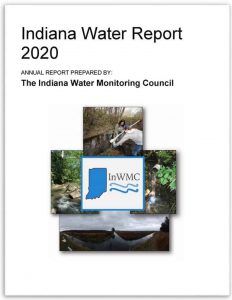From the southwestern corner of Indiana to areas across the northern part of the state, universities and colleges are undertaking countless water monitoring and research projects, data analysis, coordinating citizen science ventures, and working with other stakeholders to protect Indiana’s water resources.
The efforts of these students, professors, and staff are critical to all areas of our life from our food supply to recreation activities to our economic capacities. The latest Indiana Water Report from the Indiana Water Monitoring Council goes in depth with these university efforts during 2020.
The projects listed below are just a sample of some of the activities taking place. For more detail on these and other projects download the full 2020 Indiana Water Report.
Indiana University
The Indiana Karst Observatory
In the karst aquifers of southern Indiana, access to water (or lack thereof) is a distinct socio-economic factor impacting development. This multi-year project is gathering existing and new data, installing monitoring systems, and developing collaborative relationships to better characterize the karst hydrology in the region. Citizens, federal and state agencies, the caving community, and university students will all benefit from this study, a first after several decades of sporadic research in the area. For more information contact Lee Florea at lflorea@indiana.edu.
Climate Change Impacts
In 2020 the Department of Earth and Atmospheric Sciences developed the FutureWater Science Gateway to model how different climate change scenarios could contribute to water cycle changes in the Wabash River Basin. Utilizing surface-water and groundwater models and IU’s high-performance computing resources, the outputs of the models are visualized with detailed maps and interactive graphs. Real-time data are available for researchers, state, and non-governmental organization (NGO) staff to run their own versions of the models. Additionally this year during the COVID-19 pandemic, online learning modules were created for high school science teachers and students better understand how climate change impacts water availability in their own hometowns. To view the data or more information on the project visit the FutureWater Science Gateway website.
In a different study, efforts are underway to investigate whether sufficient data is available to identify trends in groundwater recharge over time. With different changes in precipitation due to climate change, scientists have observed how more intense snow accumulation and melt, flooding, and drought are affecting the water cycle. The study is testing the hypothesis that increasingly intense precipitation events resulting in extreme runoff events might be short-circuiting processes of replenishing groundwater. This would result in reduced freshwater availability, drought resiliency, and increase the impact of flood events.
Purdue University
State of Indiana Waters Website
Whether you are looking for a current status on Indiana’s waters or interested in viewing trends over time, the State of Indiana Waters website is a go to source for a geospatial display of the state of Indiana ground and surface waters. Purdue’s Department of Agricultural and Biological Engineering retrieves data from online databases, such as the United States Geological Survey, and uses the website to provide interactive webmaps, end of water year snapshots of select reservoirs, streamflow gages, groundwater monitoring wells, and state drought monitoring. Visit the website on November 1 of each year to view the most up to date information from the previous year.
Large-Scale High Resolution Flood Model for Entire Wabash Basin
Significant gaps exist in the availability of flood related information for the Wabash Basin which can lead to significant error in estimating the magnitude and timing of flooding as well as identifying regions that are vulnerable to flood. Using different physical processes, high-resolution datasets and high performance computing, researchers are aiming to provide accurate and dynamic flood extents for every stream in Indiana. This model will be beneficial to scientists and the public alike in improved flood warning and decision making.
Analysis of Water Use and Indirect Reuse
Unplanned, indirect water use occurs in most of the United States river systems, with complicated or little data available. At the Lyles School of Civil Engineering and Environmental Ecological Engineering, researchers completed a time series analysis of water use and unplanned indirect reuse for the Wabash River Watershed from 2009 to 2017 to determine if the available data could be integrated to provide better water resource management. Read the full study at https://www.sciencedirect.com/science/article/pii/S0048969720337426.
University of Notre Dame
Smart Water CrowdSensing Project
Through the school’s Environmental Change Initiative, seven disciplines at the University of Notre Dame plus citizen scientists of high schools in northern Indiana have been working together to model reliable and timely detection of drinking water contamination from nitrates used in fertilizer applications or leakage of septic tanks. CrowdSensing refers to citizen science, where community members participate in collecting data – in this case using test strips and lab measurements. The study investigates how data collection varies across urban, suburban, and rural communities and how crowdsensing plus data analytics can be useful to provide recommendations in groundwater management to state and regional stakeholders. More information at the project at be found at https://swcproject.weebly.com/.
Valparaiso University
Quantifying Microplastics in Lake Michigan Watershed
Valparaiso’s Department of Chemistry has initiated a project to study data collected from 2018 – 2020 concerning synthetic microfibers in Lake Michigan. Researchers will investigate the distribution and fate of these pollutants – a class of microplastics commonly found in wastewater treatment plants – which can settle into aquatic sediment or be ingested by aquatic organisms. For more information contact Julie Peller at julie.peller@valpo.edu).
Many thanks to the Indiana Water Monitoring Council for their great work in assembling the 2020 report! Read more about these water monitoring and research projects and others happening throughout the state in the full report.
Who is the Indiana Water Monitoring Council?
The Indiana Water Monitoring Council (InWMC) is a non-profit association founded in 2008 as a broad-based, state-wide body committed to enhancing the communication, collaboration and coordination of professionals, organizations, and individuals involved in monitoring Indiana’s water resources, including ground and surface waters, their physical, chemical and biological components, and associated wetland resources.

